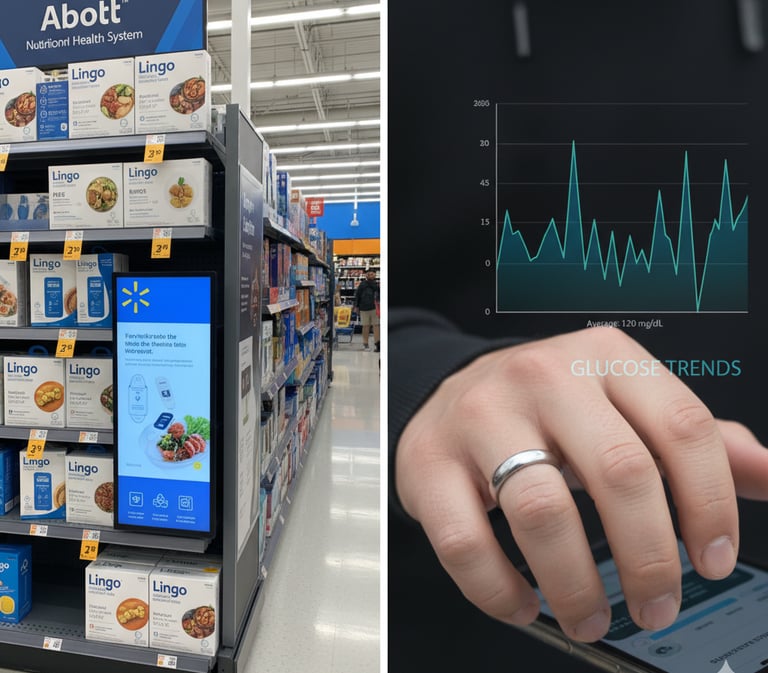"I Survived. I Lived. Then I Woke Up."
Walmart Just Put CGMs in Your Cart: Abbott Lingo vs. Oura x Dexcom Stelo, Explained
Over-the-counter glucose monitors just hit Walmart. Here’s how Abbott’s Lingo (now under $50 for 14 days) stacks up against Oura’s new integration with Dexcom Stelo—data speed, price, ease of use, and who each is best for.
PRODUCT REVIEWS
Christopher J
10/25/20253 min read


What Each Device Is
Lingo: Abbott’s consumer-oriented CGM system cleared for OTC use in the U.S., targeting health-conscious non-insulin users (and wellness users) rather than only diabetes management. Insights+3Abbott+3Abbott MediaRoom+3
Stelo: Dexcom’s OTC glucose biosensor (also U.S. cleared) that integrates with the Oura Ring and its app for broader metabolic health tracking (sleep, activity, stress + glucose)
Availability & Pricing
Lingo: According to Reuters / Axios, Walmart will carry Lingo in over 3,500 stores and online, with a 2-week supply priced at ~$48.97. Axios+1
Stelo: Reportedly available via Oura’s website and other channels; pricing around $99 for a two-sensor pack (≈ 1 month) or around $49–$50 per sensor depending on the pack. Karen Kennedy - Real Food Matters+2The Verge+2
Takeaway: Lingo is significantly cheaper per two-week period (~$49) while Stelo is higher cost (though may cover a longer wear period). If price is a big factor, Lingo looks appealing.
Features & Sampling Frequency
Lingo: A tiny sensor that sits on the back of your upper arm for up to 14 days and streams glucose data to your phone in real time. Abbott says it updates every minute, which is faster than most consumer biosensors. In plain terms: you bite into a burrito and can watch the glucose drama unfold in high resolution. The Walmart pack is listed as a 14-day supply for just under $50 and includes app access. Note: Lingo is iPhone-only right now (generally iPhone 11 or later)
Oura’s Stelo integration lets your Oura Ring and the Dexcom Stelo biosensor work together: Stelo measures your glucose, Oura tracks sleep, readiness, and activity, and the Oura app connects the dots—like how last night’s pasta impacted today’s energy. Stelo gathers glucose readings every 5 minutes, but the data typically syncs to the Oura app in 15-minute intervals. In practice, that’s “near-real-time” rather than truly live. Stelo supports both iOS and Android, and Oura’s help docs note it can take up to ~15 minutes for glucose to appear in Oura.
Integration & Ecosystem
Stelo + Oura: One of the most compelling differentiators for Stelo is the integration with the Oura Ring and App — you can view glucose data along with sleep, activity, stress, etc. The Oura “Glucose” feature relies on Stelo. Medical Device Network+2Stelo+2
Lingo: Abbott offers its own Lingo app and coaching / wellness features around nutrition, habits, metabolism. shop.hellolingo.com
Implication: If you already use or plan to use Oura Ring (or a similar ecosystem), Stelo offers a more holistic wellness stack. If you just want standalone glucose tracking with an app, Lingo suffices.
Ease of Use / For Beginners
Lingo: The lower cost, OTC availability (no prescription), and simpler model make it relatively beginner-friendly. It’s marketed for health & wellness rather than only diabetes.
Stelo: Might require pairing with Oura or use of the Stelo app, and the integration might add a layer of complexity. But the Oura ecosystem can make data contextual (sleep + glucose + activity) which is helpful for first-timers willing to engage.
Conclusion on ease: If you’re completely new, Lingo likely wins for simplicity + price. If you want deeper metrics and already track other biometrics, Stelo might be more compelling.
Which One Should You Choose?
Pick Lingo if…
• You want the lowest-friction, lowest-cost test drive (and you’re on iPhone).
• You care about immediate, minute-by-minute feedback to fine-tune meals, snacks, and timing.
• You’re experimenting with short sprints of tracking rather than a constant readout.
Pick Oura + Stelo if…
• You already use Oura, or you want sleep/HRV/activity context alongside glucose trends.
• You’re on Android (or iOS) and want broader device flexibility.
• You prioritize integrated coaching over raw speed—15-minute syncing is fine if the insights are richer.
Things to Consider / Caveats
These OTC devices are not necessarily replacements for medical CGMs used by people with insulin-dependent diabetes. They’re designed for wellness/metabolic tracking in adults who do not rely on insulin. Reuters+1
Always check compatibility (iOS vs Android), sensor wear site (upper arm vs other), battery/app requirements.
Data frequency + latency: If you want ultra-fast alerts (for example if managing hypoglycemia), a medical CGM might still be needed.
Use the data – having glucose numbers is useful, but without interpretation (meals, exercise, sleep), you might not derive actionable insight.
Over time, cost of replacing sensors/add-ons can accumulate even if upfront is low.
Accuracy and reliability can vary — always treat with some caution if using for medical decisions.
My Recommendation
If I were to recommend based on what you told (you care about accessibility, cost, convenience, easy for first-timers) — go with Lingo. The fact that it’s available OTC at major retail, lower cost (~$49 for 2 weeks), and aimed broadly at wellness makes it a strong entry point.
If you find yourself already using a wearable like Oura Ring (or open to). If you want to link glucose to sleep/activity/stress and want a longer-term integrated system, then Stelo + Oura would be the “premium” pick.

Do you have a lifechanging story and want to help others with your experience and inspiration. Please DM me or Send me and
Contact Me
© 2025. All rights reserved.
Privacy Policy
